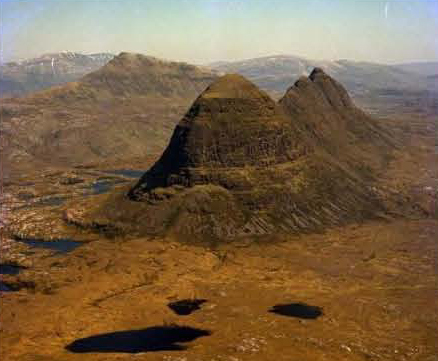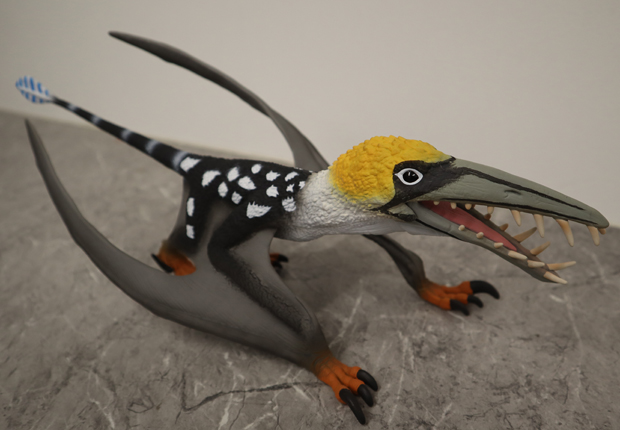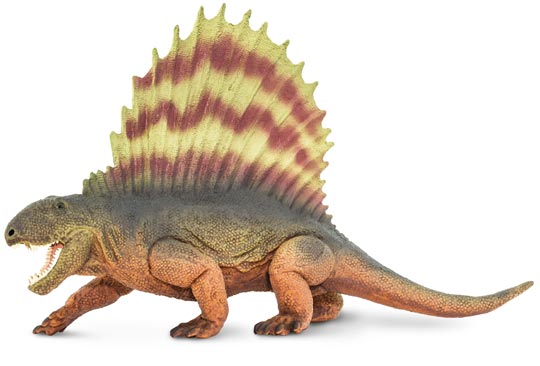Everything Dinosaur in collaboration with our friends at CollectA reveal two new prehistoric animal models for 2025. These are the last of the new reveals from CollectA for next year. A 1:40 scale replica of the giant “Megaraptor” Maip macrothorax will be introduced. In addition, collectors can expect a 1:20 scale replica of a “Terror Bird” – Phorusrhacos. Both these predators roamed South America. However, they were separated by tens of millions of years. These two, new CollectA Deluxe prehistoric animal models are welcome additions to the CollectA model portfolio.
- CollectA Deluxe 1:40 scale Maip macrothorax.
- CollectA Deluxe 1:20 scale Phorusrhacos.

The new for 2025 CollectA Deluxe M. macrothorax figure shown in lateral view.
The image (above) shows the new theropod model, the 1:40 scale Maip macrothorax model.

The CollectA Deluxe 1:20 scale Phorusrhacos model.
A spokesperson from Everything Dinosaur confirmed that these figures would be in stock at Everything Dinosaur. However, at this time, it was not possible to give an exact date. It is likely that both these figures will be available later next year, after the first batch of new models such as the CollectA Deluxe Arctodus simus had arrived.
To view the CollectA Deluxe range in stock: CollectA Deluxe Prehistoric Animal Models.
The CollectA Deluxe 1:40 Scale Maip macrothorax
Maip macrothorax (My-eep mac-row-thor-ax) was formally described in 2022 (Rolando et al). Its fossils come from the Chorrillo Formation of Santa Cruz, Argentina. Maip lived at the very end of the Cretaceous (Maastrichtian faunal stage).

A model of the Late Cretaceous “megaraptor” M. macrothorax from CollectA. The model could have an articulated lower jaw.
Creating CollectA Deluxe Prehistoric Animal Models Based on Fragmentary Fossils
Although known from fragmentary material, palaeontologists have been able to learn more about the enigmatic “megaraptors”. Maip macrothorax was a giant. With an estimated body length of around ten metres, this theropod is the largest member of the Megaraptoridae family known to science. Rib bones indicate that Maip was deep chested and extremely robust. The new CollectA Deluxe model depicts the body shape of this formidable predator nicely. For example, the model has long, strong grasping forelimbs and there is a huge claw on digit I. The terrifying Maip was named after an evil spirit of the Andes.

The CollectA Deluxe Maip macrothorax model measures 26 cm in length. The figure has a recent injury on its shoulder/coracoid. The deep lacerations indicate it was attacked by another Maip.
The model measures approximately twenty-six centimetres long. At this size, the 1:40 scale representing a dinosaur in excess of ten metres in length is quite accurate. The model has a wound on its right shoulder/coracoid. The three deep scratches indicate that it received a blow from another Maip!
To read about the discovery of Maip macrothorax: A New, Giant Megaraptor from South America.
The discovery of Maip lends support to the theory that these theropods were not members of the Allosauria clade. Instead, they were coelurosaurs and therefore related to the dinosaur lineage that gave rise to the birds. The CollectA Deluxe Maip macrothorax model has been given a flamboyant crest of feathers. In addition, there is a light covering of bristle-like feathers on the back of its neck and running down the spine as a tribute to its avian affinities.
The CollectA Deluxe 1:20 Scale Phorusrhacos
The seventh and final new CollectA figure for 2025 is a “Terror Bird” model. Fans of prehistoric animal figures have been requesting a new phorusrhacid model to accompany the CollectA Deluxe Kelenken that came out in 2011. Phorusrhacos (Four-rus-rak-cus) was a large, carnivorous, flightless bird from the Miocene of South America.

The new for 2025 CollectA Deluxe 1:20 scale Phorusrhacos model shown in an oblique posterior view.
It had a total body length of around 2.8 metres. Moreover, the head with that vicious, hooked beak stood approximately 2.4 metres tall. The skull of this formidable predator was nearly sixty-five centimetres in length. Numerous CollectA Deluxe prehistoric animal models have articulated jaws. This Phorusrhacos figure is likely to have an articulated beak.
At around fourteen centimetres in length, this model accurately reflects the 1:20 scale declaration. The model’s colouration has been influenced by the only living relative of the phorusrhacids, the seriema. The extant seriemas are the only surviving members of the order Cariamiformes which also includes the extinct Phorusrhacidae. The CollectA Deluxe Phorusrhacos model has a paint scheme similar to a red-legged seriema (Cariama cristata).
Fossilised footprints from a “Terror Bird” have revealed that these flightless birds had a large, curved claw on their second toe, just like the sickle-shaped toe claw of dromaeosaurids! The CollectA Deluxe Phorusrhacos figure shows this feature. In addition, the second toe claw is raised off the ground. This toe claw probably helped Phorusrhacos to pin down its victims.
Spotting a Detail on the Phorusrhacos Base
A broken canine tooth has been spotted on the base of the Phorusrhacos figure. Phorusrhacos is often depicted fighting sabre-toothed cats such as Smilodon. However, Phorusrhacos became extinct long before the formation of the Isthmus of Panama that united North and South America and permitted the migration of big cats into South America. During the Miocene, the main mammalian predators in South America were sparassodonts (Sparassodonta). Sabre-toothed forms evolved (Thylacosmilidae) such as Patagosmilus goini which lived during the middle Miocene. So, it is entirely plausible that a Phorusrhacos may have walked by a broken canine from a sabre-toothed sparassodont.

When viewed in left lateral view the broken canine tooth of a mammalian predator can be seen on the base of the figure.
CollectA Deluxe Prehistoric Animal Models
Mike from Everything Dinosaur confirmed that both figures would be in stock at Everything Dinosaur sometime in 2025.
He added:
“Maip and Phorusrhacos are great additions to the CollectA Deluxe model range. We are not sure when they will be available, but we will do all we can to bring them into our warehouse as quickly as possible. Thank you CollectA for sending us these exclusive images.”
Confirmation of the details of these latest CollectA Deluxe prehistoric animal models:
- CollectA Deluxe 1:40 scale Maip macrothorax (model length 26 cm approximately. This figure may have an articulated lower jaw).
- CollectA Deluxe 1:20 scale Phorusrhacos “Terror Bird” (model length 14 cm approximately. This figure may have an articulated beak).
Our thanks to CollectA for providing Everything Dinosaur with some exclusive images of these new figures.
Visit the award-winning Everything Dinosaur website: Everything Dinosaur Toys and Models.


























